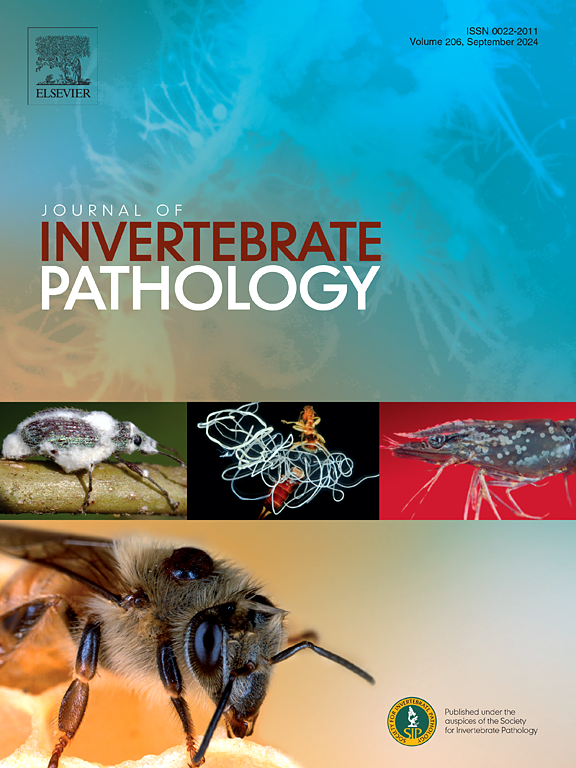预烧的微孢子虫孢子在虾体内失去了传染性
IF 2.4
3区 生物学
Q1 ZOOLOGY
引用次数: 0
摘要
肝胰腺微孢子虫病(HPM)是一种传染性疾病,引起虾类生长迟缓和大小变化,对虾类产业造成了负面影响。HPM的病原体是一种微孢子虫胞核孢子虫(肠胞虫)肝芽胞杆菌或EHP。EHP在孢子期侵入虾肝胰脏细胞,孢子遇到适宜条件时萌发。在孢子萌发过程中,一种叫做极管的特殊细胞器从孢子中挤出并刺穿宿主细胞膜。最近,我们的实验室已经确定了邻苯二甲酸氢钾(KHP)和邻苯二甲酸氢钠(NaHP)能够在体外诱导EHP孢子萌发。我们假设,如果孢子在遇到虾之前发芽,孢子将失去其传染性。为了验证这一假设,我们用KHP、NaHP和phloxine B的最佳浓度(分别为50 mM、100 mM和2%)对孢子进行预萌发。将预萌发的孢子浸入含有幼年凡纳美对虾(PL12期)的水族箱中。以1X PBS培养基中的EHP孢子为对照。浸泡14天后,以孢子壁蛋白基因为靶点,采用巢式PCR检测EHP感染情况。结果表明,所有预萌发孢子组均未发生侵染,对照组侵染率为60%。组织学证实了这些结果。用核染色染料对肝胰腺组织进行染色,结果显示对照组EHP感染阳性,而预萌发孢子组EHP感染阳性。我们的结果表明,预先萌发的EHP孢子在实验室环境中失去了传染性。KHP和NaHP作为抗ehp药剂的使用需要在农场环境中进一步测试。本文开发的体内感染试验也可以作为研究可能降低EHP孢子感染性的新化合物的管道。本文章由计算机程序翻译,如有差异,请以英文原文为准。

Pre-fired microsporidian spores lose their infectivity in shrimp
Shrimp industry has been negatively impacted by growth retardation and size variation, which are caused by an infectious disease called hepatopancreatic microsporidiosis (HPM). The causative agent of HPM is a microsporidian Ecytonucleospora (Enterocytozoon) hepatopenaei or EHP. EHP invades shrimp hepatopancreatic cells by a spore stage, which can germinate when the spore encounters suitable conditions. During the spore germination, a specialized organelle called the polar tube extrudes from the spore and pierces the host cell membrane. Recently, our lab has identified that potassium hydrogen phthalate (KHP) and sodium hydrogen phthalate (NaHP) are able to induce the EHP spore germination, in vitro. We hypothesized that if the spores are germinated prior to encountering shrimp, the spores would lose their infectivity. To test this hypothesis, we pre-germinated spores with optimal concentrations of KHP, NaHP, and phloxine B, which are 50 mM, 100 mM, and 2 %, respectively. Pre-germinated spores were immersed into the aquarium containing naive Penaeus vannamei (PL12 stage). The EHP spores in 1X PBS were used as a control. After 14 days of immersion, the EHP infections were tested by a nested PCR using a spore wall protein gene as a target. The results showed that all pre-germinated spore groups had no infection, while the infection rate was 60 % in the control group. These results were confirmed by histology. Staining the hepatopancreatic tissues using a nuclear staining dye showed positive EHP infection in the control group, but not in the pre-germinated spore groups. Our results suggest that pre-germinated EHP spores lose their infectivity in the laboratory setting. The use of KHP and NaHP as anti-EHP agents need to be further tested in the farm setting. The in vivo infection assay developed here could also be used as a pipeline to investigate new compounds that potentially decrease EHP spore infectivity.
求助全文
通过发布文献求助,成功后即可免费获取论文全文。
去求助
来源期刊
CiteScore
6.10
自引率
5.90%
发文量
94
审稿时长
1 months
期刊介绍:
The Journal of Invertebrate Pathology presents original research articles and notes on the induction and pathogenesis of diseases of invertebrates, including the suppression of diseases in beneficial species, and the use of diseases in controlling undesirable species. In addition, the journal publishes the results of physiological, morphological, genetic, immunological and ecological studies as related to the etiologic agents of diseases of invertebrates.
The Journal of Invertebrate Pathology is the adopted journal of the Society for Invertebrate Pathology, and is available to SIP members at a special reduced price.

 求助内容:
求助内容: 应助结果提醒方式:
应助结果提醒方式:


